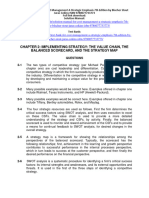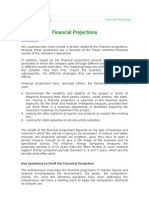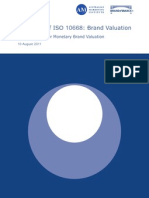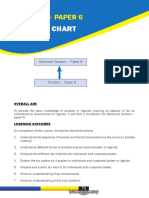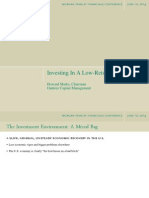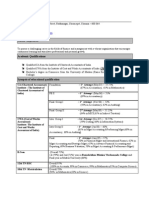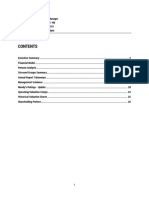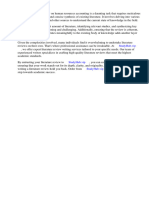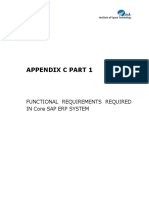Fsa Notes
Fsa Notes
Uploaded by
sanu sayedCopyright:
Available Formats
Fsa Notes
Fsa Notes
Uploaded by
sanu sayedOriginal Title
Copyright
Available Formats
Share this document
Did you find this document useful?
Is this content inappropriate?
Copyright:
Available Formats
Fsa Notes
Fsa Notes
Uploaded by
sanu sayedCopyright:
Available Formats
lOMoARcPSD|12066187
FSA Summary book and lectures
Financial Statement Analysis for E&BE (Rijksuniversiteit Groningen)
Studeersnel wordt niet gesponsord of ondersteund door een hogeschool of universiteit
Gedownload door SANU S ([email protected])
lOMoARcPSD|12066187
Financial Statement Analysis Exam Summary
Chapter 1: A Framework for Business Analysis and Valuation Using Financial
Statements
Financial statement analysis: The application of analytical tools and techniques to general
purpose financial statements and related data to derive estimates and inferences useful in
business analysis. Financial statement analysis reduces reliance on hunches, guesses and
intuitions for business decisions. It decreases the uncertainty of business analysis.
Purpose:
- Security analysis
- Credit analysis
- Mergers and acquisitions analysis
- General business analysis
- Audit risk analysis
Although savers and investors want to do business with one another, matching savings to
business investment opportunities through the use of capital markets is complicated:
- Information asymmetry entrepreneurs have better information than savers, on
the value of investment opportunities
- Potentially conflicting interests communication by entrepreneurs to savers is not
completely credible as entrepreneurs have an incentive to inflate the value of their
ideas
- Expertise asymmetry savers lack the financial sophistication to analyze and
differentiate between different business opportunities
Lemons problem: If investors cannot distinguish between good and bad ideas, investors will
value both good and bad ideas at an average level. Entrepreneurs with good ideas may find
the terms on which they can get financing to be unattractive. These entrepreneurs may
leave the market.
Financial intermediaries: banks, pension funds, insurance companies
Information intermediaries: auditors, financial analysts, credit rating agencies
A firm’s financial statements summarize the economic consequences of its business
activities.
Gedownload door SANU S ([email protected])
lOMoARcPSD|12066187
How business intermediaries use financial statements to accomplish four key steps:
1. Business strategy analysis Chapter 2
- Identifying key profit drivers and business risks
2. Accounting analysis Chapter 3+4
- Evaluate the degree to which a firm’s accounting captures the underlying business reality.
3. Financial analysis Chapter 5
- use financial data to evaluate the current and past performance of a firm and to assess its
sustainability
4. Prospective analysis Chapter 6,7,8
Gedownload door SANU S ([email protected])
lOMoARcPSD|12066187
Chapter 2: Strategy Analysis
1. Industry Analysis Assessing a firm’s profit potential of each industry in which the firm is
competing because the profitability of various industry differs systematically and predictably
over time.
Degree of actual and potential competition:
- Rivalry among existing firms
o Industry growth rate if an industry grows rapidly, firms do not need market
shares from another to grow. However, when an industry does not grow
rapidly, firms need market shares from one another to grow.
o Concentration and balance of competitors The degree of concentration
determines whether firms in an industry can coordinate their pricing and
other competitive moves.
o Excess capacity and exit barriers if capacity is larger than demand, there is
an incentive to cut prices, high exit barriers, if there is specialized assets
o Degree of differentiation and switching costs if products in an industry are
relatively similar low switching costs high competition
o Scale economies and the ratio of fixed to variable costs high fixed to
variable costs, lower prices, more competition
- Threat of new entrants
o Scale when there are large economies of scale, new entrants face the
choice of having either to invest in a large capacity which might not be
utilized right away or enter with less than the optimum capacity
o First mover advantage set industry standards
o Access to channels of distribution and relationships limited capacity and
high costs of developing new channels can act as powerful barriers to entry
o Legal barriers patent and copyrights
- Threat of substitute products or services depends on the price and relative
performance of the competing products or services and on customers willingness to
substitute.
Bargaining power in input and output markets
- Bargaining power of buyers
o Price sensitivity buyers are more price sensitive when the product is
undifferentiated and there are few switching costs
o Relative bargaining power depends on the cost to each party of not doing
business with the other party
- Bargaining power of suppliers Suppliers are powerful when there are only a few
companies and few substitutes available to their customers.
2. Competitive Strategy Analysis
- Cost leadership low input costs
- Differentiation unique products
Gedownload door SANU S ([email protected])
lOMoARcPSD|12066187
System of activities: system of activities that fit with the strategy and potentially reinforce
one another, difficult for competitors to imitate
Positioning: carve out profitable subsegment of industry based on particular product, needs
of particular group, particular access and distribution channels
3. Corporate strategy analysis:
- Low transaction costs
- Information asymmetry
Gedownload door SANU S ([email protected])
lOMoARcPSD|12066187
Chapter 3: Accounting Analysis: The Basics
Accounting analysis is to evaluate the degree to which a firm’s accounting captures its
underlying business reality and to undo any accounting distortions. When potential
distortions are large, accounting analysis can add considerable value.
Ideally all assets and liabilities would be measured at fair value; but, for different types of
assets there are no markets available, which makes it very subjective to determine fair value.
Accounting choices: Provide flexibility in how the financial statement preparers depict the
economic reality of different firms.
- Depreciation, amortization, depletion
- Inventories
- Revenue recognition
- Expenditures on assets
Potential sources of noise and bias:
- Rigidity in accounting rules
- Random forecast errors
- Systematic reporting choices made by corporate managers to achieve specific
objectives
Managers Accounting Choices
- Accounting based debt covenants Managers may make accounting decisions to
meet certain contractual obligations in their debt covenants. Contracts with banks
- Management compensation Managers compensations often comes from the fact
that their compensation and job security are often tied to reported profits
- Corporate control contests make accounting decisions to influence investor
perceptions, mergers and takeovers
- Tax considerations in countries where there is a link between financial reporting
and tax reporting
- Regulatory considerations to influence regulatory outcomes such as import tariffs
and tax policies, protect domestic industries
- Capital market considerations to influence the perception of capital markets,
beating earnings forecasts
- Stakeholder considerations influence the perception of important stakeholders,
demands of labor unions
- Competitive considerations dynamics of competition in an industry, proprietary
information
Steps in Accounting Analysis
1. Identify the key accounting policies (banks interest and credit risk management,
retail inventory management)
2. Assess accounting flexibility less flexibility is less informative
3. Evaluate accounting strategy
a. Reporting incentives
b. Deviations from the norm
c. Accounting changes
Gedownload door SANU S ([email protected])
lOMoARcPSD|12066187
d. Past accounting errors
e. Structuring transactions
4. Evaluate the quality of disclosure
a. Strategic choices
b. Accounting choices
c. Discussion of financial performance
d. Non-financial performance information when a firm invests in quality and
Kundenbetreuung
e. Segment information
f. Bad news
g. Investor relations
5. Identify Potential Red Flags
a. Unexplained changes in accounting
b. Unexplained transactions that boost profits asset sales
c. Unusual increase in trade receivables in relation to sales increases The
company is relaxing its credit policies or artificially loading up its distribution
channels to record revenues during the current period
d. Unusual increase in inventories in relation to sales could be a sign that
demand for the products is slowing down
e. Increasing gap between a firm’s reported profit and its cash flow from
operating activities
f. Increasing gap between a firm’s reported profit and its tax profit
g. Tendency to use financing mechanisms like research and development
partnerships
h. Unexpected large asset write offs
i. Large year end adjustments
j. Qualified audit opinions or changes in independent auditors that are not well
justified
k. Poor internal grade governance mechanisms
l. Related party transactions or transactions between related entities
6. Recast Financial statements and undo accounting distortions
a. Using a standard template
b. In the case of detecting financial reporting distortions, analysts should reduce
the misstatements
Standardized financial statements
- Operating investment and financing activities
o Cash flow statement, financial and operating results
- Current and non-current assets/liabilities
o Discounting
- Continued and discontinued operations
o Predicting future earnings
- Recurring and non-recurring activities
o Predicting future earnings
Note: Conservative accounting is not always good, Unusual accounting is not always bad,
Mind firms business strategy, Accounting standards are not the same as practices.
Gedownload door SANU S ([email protected])
lOMoARcPSD|12066187
Chapter 4: Accounting Analysis, Accounting Adjustments
Identify and undo accounting distortions: Analyzing the elements of the balance sheet for
possible distortions allow the analyst to better understand the economic substance of a
firm’s transactions and financial position
Balance sheet approach
Asset Distortions: Resources owned/controlled by the firm with probable future benefits
that can be measured reliably
- Doubt about whether the firm owns/controls the resource
- Doubt about future economic benefits that can be measured with certainty
- Doubt about whether fair value estimates are accurate (impairment)
Common forms of overstating assets
- Understated depreciation and amortization
- Impairment
- Leased assets
- Intangible assets
- Accelerated timing of revenue recognition
- Allowances
- Delayed write down of current assets
- Deferred tax
Common forms of understating assets
- Non-recognition of deferred tax asset
- Overstated allowances
- Discounted receivables
Liability Distortions: Economic obligations arising from benefits received in the past for
which the amount and timing is reasonably certain
- Harsh liabilities: Recognized on the balance sheet
- Provisions: recognized on the balance sheet
- Contingent liabilities: not recognized on the balance sheet
The shorter the term of the liability the less room for manipulation. The softer the liability
the more room for manipulation.
Understated liabilities may arise from
- incentives to overstate earnings or the strength of financial position
- difficulties in estimating the amount of future financial commitments
Common forms of liability understatement:
- aggressive revenue recognition, unearned revenues
- understatement of proviions
- leasing
- pension and post retirement obligation understatements
Gedownload door SANU S ([email protected])
lOMoARcPSD|12066187
Equity Distortions:
- equity is the residual claim on a firm’s assets held by stockholders, distortions on
assets and or liabilities lead to distortions in equity
Recasting financial statement sis an important step to facilitate comparability among
financial statements analyzed
Analysts should focus on evaluating and adjusting accounting measures that describe the
firms key strategic value drivers
It is important to keep in mind that many accounting adjustments will be dependent on
assumptions and estimates
Gedownload door SANU S ([email protected])
lOMoARcPSD|12066187
Chapter 5: Financial Ratio Analysis
Financial Analysis: The application of analytical tools and techniques to general purpose
financial statements and data to derive some estimates and inferences in business analysis.
- To decrease uncertainty
- To decrease reliance on guesses and intuition
Ratio Analysis: Relate line items in financial statements to measure performance
Cash Flow Analysis: Assess the management of operating, investment and financing cash
flows and firms liquidity
Time series compare over the years
Cross sectional compare within the industry
Measuring overall Profitability
ROE = comprehensive measure of performance
Net profit
ROE=
Shareholdersequity
1. Traditional approach:
Net profit margin (profit/sales)
X Asset turnover (sales/total assets)
= Return on assets
X Equity multiplier (Total assets/shareholders equity)
= Return on equity
Net profit Sales Total assets
ROE= x x
Sales Total assets Shareholders equity
Gedownload door SANU S ([email protected])
lOMoARcPSD|12066187
Income Statement Items
Interest expense after tax Interest expense x (1 – tax rate)
Net investement profit after tax (NIPAT) (investment income + interest income) x (1-
tax rate)
Net operating profit after tax (NOPAT) Net profit – NIPAT + interest expense after
tax
Balance sheet Items
Operating working capital (current assets – excess cash and cash
equivalents) – (current liabilities – current
debt and current portion of non-current
debt)
Net non-current operating assets Non-current tangible and intangible assets
+ Derivates – deferred tax liability –
noninterest bearing non-current liabilities
Investment assets (minority equity investment + other non-
operating investments + excess cash and
equivalents
Net operating assets Operating working capital + Net non-
current operating assets
Business assets Investment assets + Net operating assets
Debt Total interest bearing non-current liabilities
+ current debt and current portion of non-
current debt
Capital Debt + Equity
Nopat +Nipat Business assets interest expenseafter tax Debt
ROE= x − x
Business Assets Equity Debt Equity
ROE=ROBA + ROBA−( IEAT
Debt )
x
Debt
Equity
NOPAT + NIPAT
ROBA=
Business assets
ROE=ROBA + Spread x Financial leverage
2. Alternative approach
Net operating profit margin (Operating profit/sales)
Gedownload door SANU S ([email protected])
lOMoARcPSD|12066187
X Operating Asset turnover (Sales/Operating assets)
= Return on Net Operating Assets
X (Net operating assets/ business assets)
+ Return on investment assets (investment income/investment assets)
X (investments assets/business assets)
= Return on business assets
Spread ((NOPAT + NIPAT)/BA – IEAT/ DEBT)
X Financial leverage (Debt/equity)
= Financial leverage gain
ROE = Return on business assets + financial leverage gain
Use after tax values
Evaluating Operating Management
- Are the company’s margins consistent with its stated competitive strategy?
- Are the company’s margins changing? Look at underlying business causes in
competitions
- Changes in input costs? gross profit margin
- Is the company managing its overhead and administrative costs well? Gross profit
margin
Sales−Cost of sales
Gross Profit Margin=
Sales
NOPAT
NOPAT margin=
Sales
EBITDA
EBITDA margin=
Sales
Evaluating Investment Management
- Asset turnover firms invest in assets (sales/total assets)
o Working capital management
o Management of non-current operating assets
Working capital management ratios:
operating working capital
Operating working capital ¿ sales ratio=
Verkauf
Sales
Operating working capital turnover=
Opearting working capital
Operating working capital turnover indicates how many euros of revenue a firm is able to
generate for each euro invested in operating working capital
Gedownload door SANU S ([email protected])
lOMoARcPSD|12066187
Sales
Trade receivables turnover=
Trade receivables
Cost of sales
Inventoriesturnover =
Inventories
Purchases
Trade payables turnover=
Trade payables
Trade receivables turnover, inventories turnover and trade payables turnover allow for
examination of how productive the three principal components of working capital are used.
Trade receivables
Days receivables=
Average revenue per day
Number of days a customer’s invoice is outstanding before it is paid
Inventories
Days Inventories=
Average cost of sales per day
Number of days company holds inventory before selling it
Trade payables
Days payables=
Average purchases per day
Number of days it takes to pay creditors
Cash conversion cycle = Days inventories + Days receivables – Days payables
- Number of days it takes to receive cash from customers after having paid suppliers.
- Negative is good because it doesn’t take a lot of days to receive cash from customers
after having paid suppliers
Non-current asset management
Non current operating assets are usually plant, property and equipment, intangible assets
such as goodwill and derivatives used to hedge operating risks. Non interest bearing non
current liabilities include items such as deferred taxes
Revenue
Net non−current operating asset turnover=
Net non−current operating assets
The efficiency with which a firm uses its net non-current operating assets
Revenue
PP∧E turnover=
Net property , plant ,∧equipment
The efficiency with which a firm’s PP& E is used
Evaluating Financial Management
Gedownload door SANU S ([email protected])
lOMoARcPSD|12066187
- Use of liabilities aimed at increasing firm performance at the cost of increasing
financial risk
o Liquidity analysis relates to evaluating the ability to repay current liabilities
o Solvency analysis relates to evaluating the ability to repay longer term
liabilities
Ratios measuring the firm’s ability to repay its current liabilities
Current assets
Current ratio=
Current liabilities
Cash∧cash equivalents+trade receivables
Quick ratio=
Current liabilities
Cash∧cash equivalents
Cashratio=
Current liabilities
Cash flow
Operating cash flow ratio=¿ operations ¿
Current liabilities
Evaluate firms mix of debt and equity:
Total liabilities
Liabilites ¿ equity ratio=
Shareholdersequity
Current debt+non current debt
Debt ¿ equity ratio=
Shareholders equity
Current debt+non current debt
Debt ¿ capital ratio=
current debt +non current debt+Shareholdersequity
The ease with which a firm can meet its interest payments is an indication of the degree of
risk associated with its debt policy
Profit+interest expense+tax expense
Interest coverage earnings basis=
interest expense
Profit+interest expense after tax
Interest coverage earnings basis=
interest expense after tax
cash flow
Interest coverage cash flow basis=¿ operations+interest paid+ taxes paid ¿
interest paid
Gedownload door SANU S ([email protected])
lOMoARcPSD|12066187
The debt coverage ratio measures a firm’s ability to measure all fixed financial obligations
such as interest payments, lease payments and debt repayments.
profit +interest ∧lease expense x ( 1−tax rate )
Debt coverage cash flow basis=
interest ∧lease expense x ( 1−tax rate )+debt repayments
Sustainable growth rate
Sustainable growthrate=ROE x (1−Dividend payout ratio)
cash dividends paid
Dividend payout ratio=
profit ∨loss
Sustainable growth rate is the rate at which a firm can grow while keeping its profitability
and financial policies unchanged.
Cash flow analysis
- Cash flow analysis provide further insights into operating, investing and financing
activities. All companies under IFRS are required to include a statement of cash flows
in their financial statements
o Direct operating cash receipts are reported directly
o Indirect details the accrual adjustments that need to be made to profit or
loss in order to arrive at operating cash flows.
Gedownload door SANU S ([email protected])
lOMoARcPSD|12066187
Chapter 6: Prospective Analysis, Forecasting
Prospective analysis includes two tasks: forecasting and valuation that together represent
approaches to explicitly summarizing the analyst’s forward-looking views.
Comprehensive forecasting approach: producing not only an earnings forecast but also a
forecast for cash flows and the balance sheet.
Projecting condensed financial statements make assumptions of the ratios of chapter 5
- Income statement
- Balance sheet
- Cash flow statement
Performance behavior:
- Revenue growth behavior
o Mean reverting firms with above average or below average rates of
revenue tend to revert over time to a normal level
- Earnings behavior
o Previous year is a good starting point in considering future earnings potential
o Random walk, long term trends tend to be sustained
- Returns on equity behavior
o Mean reverting
- Behavior of components of ROE
o Look at NOPAT margin, operating asset turnover, return on investment assets,
the proportion of capital invested in operating assets, spread and financial
leverage.
Information for forecasting:
1. Predict changes in environmental and firm specific factors
a. Industry growth
2. Assess the relationship between step 1 factors and financial performance
a. Sources of performance previous years
b. Permanent performance effects
c. Trend in financial performance
3. Forecast condensed financial statements
a. Sales
b. NOPAT
c. NIPAT
d. Interest expense after tax
e. Net profit
f. Net operating working capital
g. Net operating noncurrent assets
h. Investment assets
i. Debt to capital
Assumptions:
- Macroeconomic and industry growth
o Economic circumstances
Gedownload door SANU S ([email protected])
lOMoARcPSD|12066187
o Will slow growth in the industry motivate the company to intensify price
competition?
o Brand recognition
o Quality of reported items
o Misstated past earnings and assets
- Revenue growth
o Management’s outlook
o Foreign currency and exchange rates
o Changes in H&M store portfolio
o Changes in consumer demand
- Net operating profit after taxes margins
o Input prices
o Foreign currency and exchange rates
o Inventory markdowns
o SG&A costs
o Tax rate
- Working capital to revenue
- Non-current assets to revenue
- Non-operating investments
- Capital structure
Sensitivity analysis: Forecasts should be done with more than one possible set of
assumptions in mind. Each assumption should be tested to have results for the greatest
uncertainty.
Interim forecasts: the most recent quarter’s performance
Gedownload door SANU S ([email protected])
lOMoARcPSD|12066187
Chapter 7: Prospective Analysis, Valuation Theory and Concepts
Valuation: the process of converting a forecast estimate of the value of firm’s asset or equity
Four common methods:
- Discount dividends
- Discounted cash flows
- Abnormal earnings
- Abnormal earnings growth
1. Discount Dividends
- The present value of future cash flows to shareholders is the basis of the discounted
dividends method
e
1+r ¿
¿
¿2
¿
e ....
1+r ¿
¿
¿
Dividend 1 Dividend 2
Equity Value= +
1+ℜ ¿
If Constant growth rate
Dividend
Equity value=
ℜ−g
2. Discounted Cash Flow model
- The present value of free cash flows to equity shareholders is the basis of the
discounted cash flow model
- BVA = Book value assets
- BVD = Book value debt
FreeCash Flow=Profit −Change∈book value of net assets+ Change∈book value of debt
e
1+r ¿
¿
¿2
¿
e
.
1+r ¿
¿
¿3
¿
FCF 1 FCF 2
Equity Value= + ¿
1+ℜ
Gedownload door SANU S ([email protected])
lOMoARcPSD|12066187
Enterprise value = equity value + value of debt
3. The Discounted Abnormal Profit Model
- Abnormal earnings are those that differ from the expected return
- BVE = Book value equity
BVE 1=BVE 0+ profit −dividend
Dividend= profit + BVE 0−BVE 1
profit −ℜ∗BVE 0 profit−ℜ∗BVE 1
Equity=BVE 0+ +
1+ℜ ( 1+ ℜ )2
Winst boven re *BVE0 abnormal earnings, discount
4. The Discounted Abnormal Profit Growth Model
- Abnormal earnings growth is the annual change in abnormal earnings
Valuation Using Price Multiples
- Step 1: select a measure of performance or value
- Calculate the price multiples for comparable firms
- Apply the comparable firm multiple to the performance or value measure of the firm
being analyzed
e
1+r ¿
¿
¿2
¿
e
1+r ¿
¿
¿
ROE 1−ℜ ( ( ROE 2−ℜ ) (1+ g 1 equity ) )
Equity value ¿ book multiple=1+ +
1+ ℜ ¿
BVEt −BVE t −1
gtequity=
BVE t−1
Equity value=Initial Book value∗Equity value¿ b ook multiple
Gedownload door SANU S ([email protected])
lOMoARcPSD|12066187
Issues:
- selecting comparable firms
- multiples for firms with poor performance
- adjusting multiples for leverage
Gedownload door SANU S ([email protected])
lOMoARcPSD|12066187
Chapter 8: Prospective Analysis, Valuation Implementation
Key issues to implement valuation
1. Determining the discount rate
2. Making forecasts of financial performance
a. Detailed forecasts over a number of years
b. Arriving at a forecasted terminal value
3. Choosing equity valuation vs. asset valuation
Capital asset pricing model
ℜ=rf + B equity [ E ( rm ) −rf ]
Risk free rate = rate on intermediate term government bonds
Market risk premium: excess of the expected return on the market over the risk-free rate
Beta: historical association between firm specific and market returns
[
Bequity= 1+ ( 1−tax rate ) x
Debt
Equity ]
BBusiness assets
Adjusting for leverage and non-operating investments:
WACC – Weighted average cost of capital
- The appropriate discount rate to value a company’s assets is the WACC, which takes
into account debt and equity sources of financing
Gedownload door SANU S ([email protected])
lOMoARcPSD|12066187
Debt Equity
WACC= ( 1−tax rate ) x cost of debt + cost of equity
Debt + Equity Debt + Equity
Terminal Value: is the final year of the forecast and represents the present value of future
abnormal earnings or free cash flows for the remainder of the firm’s life.
( 1+ g )∗abnormal earnings
TV =
ℜ−g
(1+ g )∗abnormal earnings
ℜ−g
Discounted TV =
(1+ℜ )n
Gedownload door SANU S ([email protected])
lOMoARcPSD|12066187
Chapter 9: Equity Security Analysis
Security analysis: the evaluation of a firm and its prospects from the perspective of a
current or potential investor in the firm’s shares.
The process of gathering and organizing information and then using it to determine the
intrinsic value of a firm’s equity
Aim:
- Determining investment opportunities
o Establishing investment objectives
o Developing expectations about future returns and risks of individual securities
o Combining individual securities into portfolios that meet investment
objectives
- Projecting future returns and assessing risk
o Identification of mispriced stocks
Collective investment funds: funds that sell shares in professionally managed portfolios that
invest in specific types of equity and income securities
Efficient Markets Hypothesis: Posits that security prices reflect all available information fully
and immediately upon its release
- Perfectly efficient markets impossible to identify mispriced stocks
- If markets are extremely efficient the few who receive newly announced financial
information could trade advantageously on it before it is fully disseminated to the
rest of the market
Importance of security analysis
- All of the people doing fundamental analysis is the reason the market is efficient
- Financial markets may not be perfectly efficient
- Pricing errors are inevitable
Security analysis – Traditional approach
- Step 1: economic analysis
- Step 2: industry analysis
- Step 3: fundamental analysis
o Financial condition
o Historical behavior
Security analysis – comprehensive approach
- Step 1: selection of candidates to analyze
o Specialization by industry sector or potential mispricing basis allows more
depth of analysis
- Step 2: inferring market expectations
o Identifying potentially mispriced securities requires a comparison of the
analysts’ expectations with those of the market
Gedownload door SANU S ([email protected])
lOMoARcPSD|12066187
- Step 3: developing analysts expectations
o Forecast of earnings and cash flows with an estimate of value must be derived
from the analyses performed
- Step 4: the final product of security analysis
o Financial analysts must ultimately recommend some action to take on a
security based on the analyses conducted
Intrinsic value > market value buy
Intrinsic value < market value sell
Intrinsic value approximates market value hold or review
Gedownload door SANU S ([email protected])
lOMoARcPSD|12066187
Chapter 10: Credit Analysis and Distress Prediction
Credit Analysis: The evaluation of the risk of a firm in terms of repayment ability from the
perspective of a current or potential holder of its debt, trade payables, loans or any liability.
- Numerous parties are interested in creditworthiness of a company including banks,
investors, suppliers, auditors and employees
- Debt is an important source of financing though there are trade-offs in financing with
debt instead of equity capital
Why firms use debt financing
- Interest tax shield
o Deduct interest paid on debt as an ordinary business expense
- Management incentive alignment
o Imposes a discipline on management to create value reducing conflicts of
interests between managers and shareholders
Downsides:
- Higher likelihood of financial distress
o Legal costs
o Damage to ability to raise capital
o Costs of conflicts between creditors and stockholders
-
Country differences in debt financing
- Extent to which national bankruptcy laws protects debt providers
- Multiple bank borrowing
- Supplier financing
- Off balance sheet financing
- Public debt
- Borrower friendly and creditor unfriendly countries
The better the firms business prospects, the lower the risk to the creditor
Credit analysis process in private debt markets
- Consider the nature and purpose of the loan
o Terms, size and duration of the loan
- Consider the type of loan and available security
o Type and amount of security needed to collaterize the loan
- Conduct financial analysis
o Liquidity
o Solvency
- Assemble loan structure and debt covenants
o Maintenance ratio of minimum net worth
o Minimum coverage ratio
o Maximum ratio of total liabilities ot net worth
o Minimum net working capital balance to current raito
Gedownload door SANU S ([email protected])
lOMoARcPSD|12066187
o Maximum ratio of capital expenditures to earnings before depreciation
Financial statement analysis and public debt:
- Rating system from D to AAA that grades the relative riskiness of debt, debt ratings
influence the yield that debt instruments must pay for investors to buy them.
o AAA most profitable
o D indicates default
- Factors driving debt ratings
o Profitability measures return on net capital
o Leverage measures
o Profitability and leverage
o Firm size
o Cash flow performance
o Riskiness of profit stream
Prediction of distress
- Altmans z score model, which weights five variables to compute a banktrupcy score
- X1 = net working capital/total assets measure of liquidity
- X2 = retained earnings/total assets measure of cumulative profitability
- X3 = EBIT/total assets measure of return on assets
- X4 = market value of equity/book value of total liabilities measure of market
leverage
- X5 = revenue/total assets measure of revenue generating potential of assets
Z =1.2 X 1+1.4 X 2+3.3 X 3+0.6 X 4+1.0 X 5
When Z < 1.81, model predicts bankruptcy
Gedownload door SANU S ([email protected])
You might also like
- ACCT3302 Financial Statement Analysis Tutorial 1: Introduction To Financial Statement AnalysisDocument3 pagesACCT3302 Financial Statement Analysis Tutorial 1: Introduction To Financial Statement AnalysisDylan AdrianNoch keine Bewertungen
- Project Report For New Business - FormatDocument4 pagesProject Report For New Business - FormatRajiv Ranjan0% (1)
- Project Report of Business PlanDocument8 pagesProject Report of Business PlanRavi SatyapalNoch keine Bewertungen
- RusselJ. Fuller and Chi-Cheng Hsia A Simplified Common Stock Valuation ModelDocument9 pagesRusselJ. Fuller and Chi-Cheng Hsia A Simplified Common Stock Valuation ModelShivani RahejaNoch keine Bewertungen
- Financial Statement Analysis NotesDocument25 pagesFinancial Statement Analysis NotesparinNoch keine Bewertungen
- Chapter 0Document40 pagesChapter 0Võ Thị Mỹ DuyênNoch keine Bewertungen
- Key Account MGMTDocument17 pagesKey Account MGMTPradeep AdsareNoch keine Bewertungen
- Financial Projection Analysis Report For StudentsDocument6 pagesFinancial Projection Analysis Report For StudentsArchie TonogNoch keine Bewertungen
- FMCG, Rating Methodology, Oct 2015 (Archived)Document5 pagesFMCG, Rating Methodology, Oct 2015 (Archived)Nikhilesh JoshiNoch keine Bewertungen
- Session 02 Business AnalysisDocument30 pagesSession 02 Business AnalysisSajini KaushalyaNoch keine Bewertungen
- Competitor AnalysisDocument10 pagesCompetitor Analysissajanmarian100% (1)
- Ufa#Ed 2#Sol#Chap 06Document18 pagesUfa#Ed 2#Sol#Chap 06api-3824657Noch keine Bewertungen
- Financial AnalysisDocument17 pagesFinancial AnalysistonyNoch keine Bewertungen
- Process of Fundamental Analysis PDFDocument8 pagesProcess of Fundamental Analysis PDFajay.1k7625100% (1)
- Chapter Five Security Analysis and ValuationDocument66 pagesChapter Five Security Analysis and ValuationKume MezgebuNoch keine Bewertungen
- 36 - Finance and Accounting Strategy: 36.1 The Use of Accounting Data in Strategic Decision-MakingDocument11 pages36 - Finance and Accounting Strategy: 36.1 The Use of Accounting Data in Strategic Decision-MakingRokaia MortadaNoch keine Bewertungen
- PRESENTATION Criticisms Strategic Management AccountingDocument38 pagesPRESENTATION Criticisms Strategic Management AccountingAzri Mohamed YusofNoch keine Bewertungen
- Intra Industry AnalysisDocument9 pagesIntra Industry AnalysisManzzieNoch keine Bewertungen
- Resume Frank Rothaermel - Strategic Management Chapter 5&6 - Dani Yustiardi 1906419822Document8 pagesResume Frank Rothaermel - Strategic Management Chapter 5&6 - Dani Yustiardi 1906419822Dani Yustiardi MunarsoNoch keine Bewertungen
- Resume Frank Rothaermel - Strategic Management Chapter 5Document3 pagesResume Frank Rothaermel - Strategic Management Chapter 5Dani YustiardiNoch keine Bewertungen
- Business Notes Plus Button Battery SpeechDocument14 pagesBusiness Notes Plus Button Battery Speechhussainshakeel.mzNoch keine Bewertungen
- 2324 EmeDocument9 pages2324 EmeJonas EdwardNoch keine Bewertungen
- Strategy - Chapter 5Document5 pagesStrategy - Chapter 532_one_two_threeNoch keine Bewertungen
- Business EconomicsDocument10 pagesBusiness Economicswaghprashant822Noch keine Bewertungen
- Solution Manual For Cost Management A Strategic Emphasis 7Th Edition by Blocher Stout Juras Cokins Isbn 9780077733773 Full Chapter PDFDocument36 pagesSolution Manual For Cost Management A Strategic Emphasis 7Th Edition by Blocher Stout Juras Cokins Isbn 9780077733773 Full Chapter PDFearlene.devins297100% (11)
- Fsa 12NDocument4 pagesFsa 12Npriyanshu.goel1710Noch keine Bewertungen
- Financial Analytics NotesDocument38 pagesFinancial Analytics Notessridhara.ramkarthik173Noch keine Bewertungen
- Framework For Business Analysis and Valuation Using Financial StatementsDocument18 pagesFramework For Business Analysis and Valuation Using Financial StatementsFarhat987Noch keine Bewertungen
- Reviewer FMDocument8 pagesReviewer FMTHRISHIA ANN SOLIVANoch keine Bewertungen
- Smart Task 3 OF Project Finance by (Vardhan Consulting Engineers)Document7 pagesSmart Task 3 OF Project Finance by (Vardhan Consulting Engineers)devesh bhattNoch keine Bewertungen
- Strategy and Capital AllocationDocument32 pagesStrategy and Capital AllocationsonalNoch keine Bewertungen
- Unit 4 and 5Document10 pagesUnit 4 and 5avanishbajpai2022Noch keine Bewertungen
- Unit 4Document10 pagesUnit 4avanishbajpai2022Noch keine Bewertungen
- Process of Fundamental Analysis PDFDocument8 pagesProcess of Fundamental Analysis PDFbharti khandelwalNoch keine Bewertungen
- April 2010 - Show Me The MoneyDocument8 pagesApril 2010 - Show Me The MoneylithonNoch keine Bewertungen
- Financial Projections: Key Questions To Draft The Financial ProjectionDocument11 pagesFinancial Projections: Key Questions To Draft The Financial ProjectionAmit MaisuriyaNoch keine Bewertungen
- Strategic Cost Management PDFDocument10 pagesStrategic Cost Management PDFMohamad RifkyNoch keine Bewertungen
- EssaysDocument120 pagesEssayskritesh1810Noch keine Bewertungen
- Chapter 8 Relative & Real Option Valuation BasicsDocument8 pagesChapter 8 Relative & Real Option Valuation Basics1954032027cucNoch keine Bewertungen
- Explain The Difference in Attitude To Risk Between European and US CompaniesDocument3 pagesExplain The Difference in Attitude To Risk Between European and US CompaniesJomer FernandezNoch keine Bewertungen
- Project Finance (Smart Task 3)Document13 pagesProject Finance (Smart Task 3)Aseem Vashist100% (1)
- Case StudyDocument5 pagesCase StudyAnwar JaveriaNoch keine Bewertungen
- Chapter 12 NavidadDocument2 pagesChapter 12 NavidadPdean DeanNoch keine Bewertungen
- Implementing Strategies: A Look At: Marketing, Finance / Accounting, R& D and MIS IssuesDocument39 pagesImplementing Strategies: A Look At: Marketing, Finance / Accounting, R& D and MIS IssuesJohn HenryNoch keine Bewertungen
- Source-to-Pay: Advancing From Pure Cost Optimization To Value GenerationDocument8 pagesSource-to-Pay: Advancing From Pure Cost Optimization To Value GenerationCognizantNoch keine Bewertungen
- Industry AnalysisDocument29 pagesIndustry AnalysisMarie Joy CentinoNoch keine Bewertungen
- ExpendituresDocument5 pagesExpendituresSheikh MarufNoch keine Bewertungen
- Limitations of Financial Statement AnalysisDocument5 pagesLimitations of Financial Statement AnalysisJemilyn Cervantes-Segundo0% (2)
- Manufacturing CompaniesDocument5 pagesManufacturing CompaniesVineet_Sharma_9432Noch keine Bewertungen
- ISO0668 Overview Brand FinanceDocument16 pagesISO0668 Overview Brand FinanceDurban Chamber of Commerce and IndustryNoch keine Bewertungen
- Financial Management: AssignmentDocument6 pagesFinancial Management: Assignmentsadiaimam103Noch keine Bewertungen
- Buy-Side Business Attribution - TABB VersionDocument11 pagesBuy-Side Business Attribution - TABB VersiontabbforumNoch keine Bewertungen
- Fiche Strategic Management 2Document31 pagesFiche Strategic Management 2baillon.andreamaria9Noch keine Bewertungen
- IBE NDIM Country Risk and Evaluation Lecture 21Document22 pagesIBE NDIM Country Risk and Evaluation Lecture 21Kunal AgarwalNoch keine Bewertungen
- BAV Lecture 1 and 2Document19 pagesBAV Lecture 1 and 2Fluid TrapsNoch keine Bewertungen
- Fundamentals of Valuation: Chapter One: IntroductionDocument16 pagesFundamentals of Valuation: Chapter One: IntroductionAhmed RedaNoch keine Bewertungen
- Article Deloitte One SizeDocument4 pagesArticle Deloitte One Sizedavidlaval79Noch keine Bewertungen
- We TubeDocument38 pagesWe TubeGaurav ChikhalikarNoch keine Bewertungen
- Strategic ManagementDocument10 pagesStrategic ManagementVinod JakharNoch keine Bewertungen
- Engineering Economics & Accountancy :Managerial EconomicsFrom EverandEngineering Economics & Accountancy :Managerial EconomicsNoch keine Bewertungen
- BL 5 Audit, Business ProcessesDocument188 pagesBL 5 Audit, Business Processessanu sayed100% (1)
- SL 1 Advanced Business ReportingDocument300 pagesSL 1 Advanced Business Reportingsanu sayed100% (1)
- Excel Modeling Teaching GuideDocument237 pagesExcel Modeling Teaching Guidesanu sayed100% (1)
- SL 3 Corporate TaxationDocument73 pagesSL 3 Corporate Taxationsanu sayedNoch keine Bewertungen
- BL 3 Business LawDocument77 pagesBL 3 Business Lawsanu sayedNoch keine Bewertungen
- BL 7 Business TaxationDocument63 pagesBL 7 Business Taxationsanu sayedNoch keine Bewertungen
- CL 4 Corporate LawDocument80 pagesCL 4 Corporate Lawsanu sayedNoch keine Bewertungen
- BL 4 Business EnvironmentDocument164 pagesBL 4 Business Environmentsanu sayed100% (1)
- BL 2 Business MathamaticsDocument226 pagesBL 2 Business Mathamaticssanu sayed100% (1)
- CL 1 Advanced AuditDocument330 pagesCL 1 Advanced Auditsanu sayed100% (1)
- Advanced Excel NotesDocument668 pagesAdvanced Excel Notessanu sayed100% (1)
- BL 6 Management AccountingDocument254 pagesBL 6 Management Accountingsanu sayedNoch keine Bewertungen
- CPA Paper 15Document9 pagesCPA Paper 15sanu sayedNoch keine Bewertungen
- Risk Management NotesDocument10 pagesRisk Management Notessanu sayedNoch keine Bewertungen
- BL 1 Financial AccountingDocument176 pagesBL 1 Financial Accountingsanu sayedNoch keine Bewertungen
- CPA Paper 12Document15 pagesCPA Paper 12sanu sayedNoch keine Bewertungen
- CPA Paper 7Document11 pagesCPA Paper 7sanu sayedNoch keine Bewertungen
- CPA Paper 13Document16 pagesCPA Paper 13sanu sayedNoch keine Bewertungen
- CPA Paper 16Document9 pagesCPA Paper 16sanu sayedNoch keine Bewertungen
- CPA Paper 14Document20 pagesCPA Paper 14sanu sayedNoch keine Bewertungen
- CPA Paper 17Document14 pagesCPA Paper 17sanu sayedNoch keine Bewertungen
- CPA Paper 11Document9 pagesCPA Paper 11sanu sayedNoch keine Bewertungen
- CPA Paper 8Document15 pagesCPA Paper 8sanu sayedNoch keine Bewertungen
- CPA Paper 9Document8 pagesCPA Paper 9sanu sayedNoch keine Bewertungen
- CPA Paper 10Document6 pagesCPA Paper 10sanu sayedNoch keine Bewertungen
- Investment Banking Lesson 4Document66 pagesInvestment Banking Lesson 4sanu sayedNoch keine Bewertungen
- CPA Paper 6Document20 pagesCPA Paper 6sanu sayed100% (1)
- CPA Paper 5Document15 pagesCPA Paper 5sanu sayedNoch keine Bewertungen
- Investment Banking Lesson 5Document70 pagesInvestment Banking Lesson 5sanu sayedNoch keine Bewertungen
- Investment Banking Lesson 1Document66 pagesInvestment Banking Lesson 1sanu sayedNoch keine Bewertungen
- BALCO Union V Union of India 2002Document36 pagesBALCO Union V Union of India 2002Manisha Singh0% (1)
- Product Cost Planning (041 080)Document40 pagesProduct Cost Planning (041 080)CELSO SANTOSNoch keine Bewertungen
- Pak Apr Jun 2010Document40 pagesPak Apr Jun 2010wasim0692890Noch keine Bewertungen
- Cost Value ReconciliationDocument18 pagesCost Value ReconciliationNeminda Dhanushka Kumaradasa0% (1)
- Intrinsic Value Spreadsheet 1Document12 pagesIntrinsic Value Spreadsheet 1Soham AherNoch keine Bewertungen
- Istilah Akuntansi Di Awali Huruf ADocument21 pagesIstilah Akuntansi Di Awali Huruf ArantosbNoch keine Bewertungen
- JChiang ResumeDocument1 pageJChiang Resumemancision100% (1)
- YupDocument180 pagesYupFery AnnNoch keine Bewertungen
- Presentation - Valuation and Income Tax Act 1961Document71 pagesPresentation - Valuation and Income Tax Act 1961Vaibhav JainNoch keine Bewertungen
- Howard Marks PresentationDocument11 pagesHoward Marks PresentationCanadianValueNoch keine Bewertungen
- Full Download Real Estate Principles A Value Approach Ling 4Th Edition Test Bank PDFDocument43 pagesFull Download Real Estate Principles A Value Approach Ling 4Th Edition Test Bank PDFmaryann.spiller922100% (26)
- Balaji Resume - DeLOITTEDocument3 pagesBalaji Resume - DeLOITTETerence LewisNoch keine Bewertungen
- PepsicoDocument12 pagesPepsicomonish147852Noch keine Bewertungen
- Certainity EquivalentDocument3 pagesCertainity EquivalentDhruv Ratan DeyNoch keine Bewertungen
- Yes Bank Update Note Jun 19Document26 pagesYes Bank Update Note Jun 19rajivagarwalNoch keine Bewertungen
- HDFC Mid-Cap Opportunities Fund - Presentation (Apr 2023)Document28 pagesHDFC Mid-Cap Opportunities Fund - Presentation (Apr 2023)RajNoch keine Bewertungen
- Financial Statement Analysis Wipro LTDDocument35 pagesFinancial Statement Analysis Wipro LTDAnitha PanneerselvamNoch keine Bewertungen
- Research ProposalDocument8 pagesResearch ProposalKeyur PopatNoch keine Bewertungen
- VC ThesisDocument8 pagesVC Thesisafloaaffbkmmbx100% (2)
- Literature Review On Human Resources AccountingDocument5 pagesLiterature Review On Human Resources AccountingjtxyihukgNoch keine Bewertungen
- ValmetDocument7 pagesValmetJulia MercadoNoch keine Bewertungen
- Appendix C Part 1 Functional Requirements Required in Core Sap ErpDocument62 pagesAppendix C Part 1 Functional Requirements Required in Core Sap ErpMaheen AhmedNoch keine Bewertungen
- BBA Second Year (Third Semester)Document29 pagesBBA Second Year (Third Semester)Aman quraishiNoch keine Bewertungen
- A Study of Gold Loan in Muthoot Finanance Limited: Prof. B. ShivarajDocument14 pagesA Study of Gold Loan in Muthoot Finanance Limited: Prof. B. ShivarajAbhijith V AshokNoch keine Bewertungen
- FM - Valuation of Bond and StocksDocument10 pagesFM - Valuation of Bond and StocksMaxine SantosNoch keine Bewertungen
- Aped Manual Volume I 2012Document463 pagesAped Manual Volume I 2012Arif Ahmed100% (1)
- Iisa Seminar Valuation of Plant & MachineryDocument17 pagesIisa Seminar Valuation of Plant & MachineryParikh Hardik DNoch keine Bewertungen
- IFRS Edition-2nd: Conceptual Framework For Financial ReportingDocument30 pagesIFRS Edition-2nd: Conceptual Framework For Financial ReportingAhmed SroorNoch keine Bewertungen
- Unlocking Esg Opportunies Explore How Esg Impacts enDocument18 pagesUnlocking Esg Opportunies Explore How Esg Impacts enSajid KhanNoch keine Bewertungen
























